FTTH Case Studies - Building A "Terabit City" And "Do-It-Yourself" FTTH
Building A "Terabit City
Why Stop At Gigabits? Design Fiber Networks For Terabits - It's The Future!
When discussing fiber infrastructure for cities, we mostly talk about
"Gigabit Cities," which are certainly the state of the art today. GPON
or 10GPON are the way to provide gigabit FTTH, and DOCSIS-3 or RFOG can
provide similar bandwidth for CATV systems. 5G and WiFi 6 wireless
promise almost as much bandwidth, although they are still unproven.
But fiber optic networks are good for 20-40 years at least, so what
happens as time moves on? Is Gigabit good enough? Based on past history
of the communications networks and the Internet, the answer is obvious,
of course not. So doesn't it make sense to design fiber optic networks
today that will be good in the future - the Terabit future?
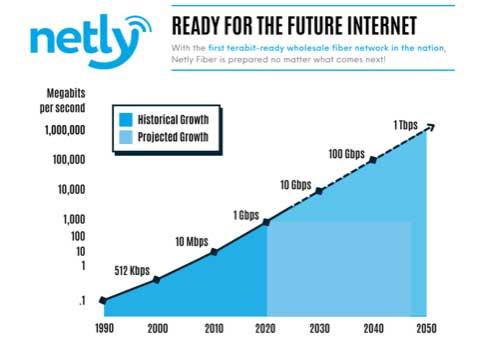
Graph of Internet speeds from Netly Fiber.
Another issue that makes sense is "open access." If the owners of the
fiber optic cable plant are not service providers, they can provide the
connections to the users and allow multiple ISPs, CATV companies,
telcos, etc. to colocate in their head end. If a customer wants to add
or change service providers, only a simple patchcord change is needed.
Open access networks are preferable for cities because it can allow more
flexibility in offering services to citizens and for the city's own
uses.
Can networks like this be built today? That's what a company called
Netly Fiber has done in Solana Beach, CA. In June 2022, Netly completed
their 2-year project of building a fiber network in Solana Beach that
shows that with some forethought, you can build "Terabit" fiber optic
networks today that should be good for the lifetime of the fiber.
(An aside: When Jack Demers, an entrepreneur in
wireless, got interested in fiber over 5 years ago, he called FOA
asking questions. He came to our office and spent most of a day
discussing the work we had done with FTTH, starting with helping Verizon
with FiOS and our recent work in the DIY projects like Southern
Fiberworx and Connect Anza. We discussed a lot of topics that day and
since then we have continued our conversations as Netly has gotten
started and begun operations. And, for full disclosure, your editor, JH, was a minor shareholder in Netly.)
What exactly is Netly doing that is different? The multi-million dollar
project took two years to complete and includes ultra-high speed dark fiber access for every residence, business, traffic light, and institution in the city.
To achieve terabit speeds the Netly team took a bold approach and built
multiple dedicated strands of fiber to each address located on city
streets. Over 30,000 fibers are available for Solana Beach's 6,000
households.
Yes, every user in the city can have dedicated fiber back to Netly's head end. And the fiber network is open access;
Netly is not an ISP, telecom or CATV company, they just provide the
dark fibers and colocation space for service providers. Service
providers locate their equipment at Netly's head end, patch into their
customers' fibers and provide their services using whatever protocols
they choose.
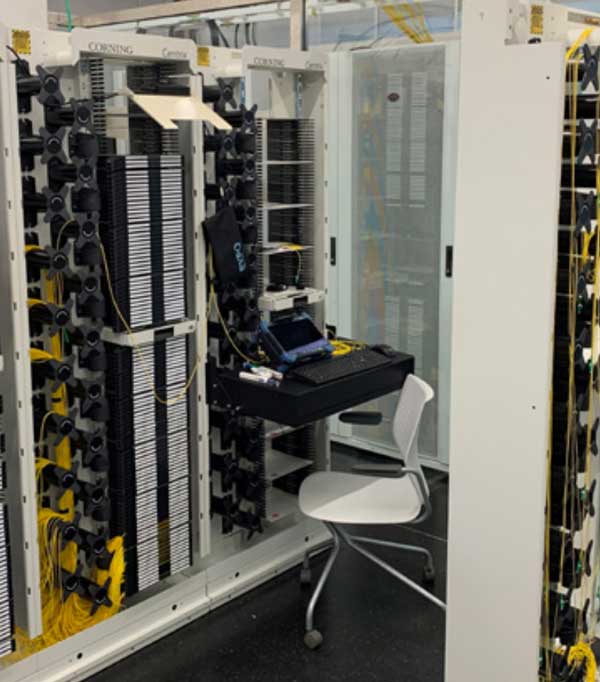
Service providers' equipment (including splitters for PON networks) are placed in the Netly Edge Fiber Center (headend)
Does a centralized fiber infrastructure make sense? Most networks today
are based on PONs, passive optical networks that use splitters to serve
multiple users from a single network GPON OLT port over one fiber, with
splitters placed along the network route. But will that architecture
still work in a decade or two? Possible, as 10G is already here and 100G
PONs using coherent transmission in R&D. And, then again, maybe
not. In the future we may need direct connection to every user.
The centralized fiber network Netly uses is really cheap insurance for
the future. If you are using GPON on Netly's cable plant today, you put
your OLT in their head end along with the PON splitters and connect to
every user on their dedicated fiber. If the architecture changes to
direct connection to the user in the future, a simple change of
equipment is all that is needed.
Is centralized fiber affordable today? Netly thinks so. But they are utilizing state-of-the-art products and technologies.
Based on his analysis of the market and new developments in technology,
Jack developed a unique business plan for Netly. The notion of
centralized fiber with a connection to every user makes sense today
because fiber is inexpensive and this architecture reduces the need for
numerous fiber distribution hubs and pedestals for splitters or other
equipment scattered around the service areas. And centralized fiber
architecture is ready for terabit applications.
For the cities on the Southern California coast Netly was interested in,
all were somewhat urban but mostly suburban in geography. Underground
installation would be required in areas where aerial cables were not
permitted, so using microtrenching made sense for the installation
method. Working with Corning, Netly chose a microcable that could be
blown into microducts. Each trench route has a microduct with six ducts
in a row. When only one duct was used, 288 fibers in the microcable were
available, but each route could be expanded to 6 of the 288 fiber
microcables for 1728 fibers total.
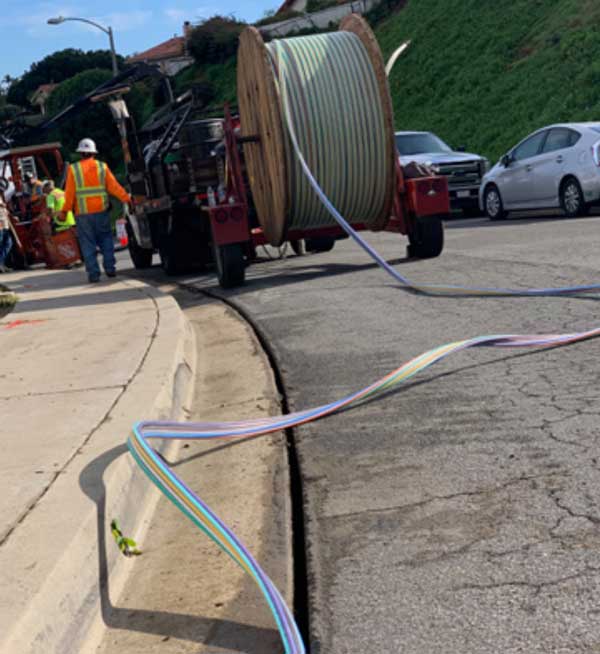
Netly microtrenches then installs 6 microducts.
Netly's microtrenching technique deserves a mention also. Where
possible, that is there are no conflicts with other buried utilities,
they trench at
the joint between the road pavement and the curb, minimizing damage to
either. Drops are done in small handholes near the curb, leaving an
installation that is almost undetectable. And installation is quick,
making for minimal disruption in a neighborhood.
Besides a unique model for the FTTH cable plant, Netly has used a
different model for their financing. Netly is funded by private
investors who believe this is the best model for FTTH networks and
offers the greatest potential for future growth.
Do It Yourself FTTH
Do
you think that creating a FTTH network is only
possible if you have the resources of a Verizon or
Google? That you need a contractor with lots of
experience in designing and installing the fiber
network? Or an IT department who can install and
operate the equipment? Well, think again...AND
IF YOU ARE INTERESTED IN DIY FTTH, DO NOT MISS THE
INFORMATION AT THE END OF THESE STORIES!
With
most people agreeing that broadband Internet is an
essential utility, the problem becomes how to get it to
places that incumbent service providers don't have any
interest in serving because of the cost? More and more
groups are deciding to do it themselves. DIY FTTH is
completely feasible and hundreds of organizations are
doing it already. These DIY FTTH projects are being done
by cities and towns, utility coops, especially electrical
coops who need fiber for their grid management anyway, as
well as private groups like homeowners' associations, real
estate developers and even private companies with venture
capital funding.
Perhaps the best known is the Electricity
Power Board of Chattanooga, TN, EPB has shown that
gigabit broadband can transform a sleepy city into a
booming manufacturing (VW factory) and tech city. But you
don't need to be as big as EPB to bring broadband to your
area as these two examples show.
Southern
Fiberworx, Cordelle, GA
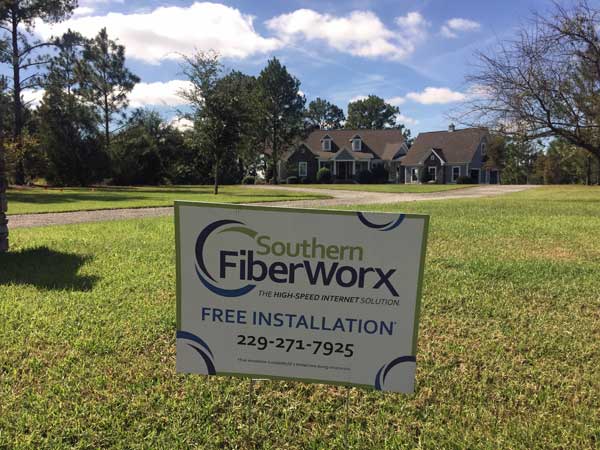
About
2014, FOA was contacted by Greg Turton of Cordele, GA. who
was curious about what was involved in creating a FTTH
network. Greg is a real estate developer who also owns
several local hotels. Where he lives and builds homes is
way outside of a service area that anybody wants to build
good broadband, forget FTTH. Cordele itself has a
population of only about 15,000 and is one of those small
cities along the Interstate highway that are everywhere in
the US.
We answered Greg's questions and led him to some of the
FOA Guide web pages and YouTube videos about FTTH to get
him started. More conversations discussed how to get
connections as an ISP, types of components and suppliers,
etc. Fortunately the local electrical utility has lots of
fiber but they were restricted from building their own
FTTH network because Georgia was one of 19 states where
lobbyists for the incumbent providers got laws passed
restricting their ability to operate a FTTH system
themselves. But they were more than willing to lease dark
fiber to Greg at really good rates. And there were good
choices on getting an Internet connection. As he got more
serious about the project, we introduced him to two FOA
Master Instructors, Eric
Pearson and Dominick
Tambone, in Atlanta, just two hours away.
Greg hired Eric to come to Cordele and train him and
several more of his people. Eric taught them how to work
with cable, prepare the cable and splice it, dress cables
in splice closures, pedestals, manholes, etc. Eric,
Dominick and the FOA had many conversations with Greg
about his project and the potential suppliers to it. As
construction began, Dominick came down to Cordele to help
with the early installations.
Now that you know where we're going with this story, let's
talk about Greg. He is not your usual fiber optic project
manager. First he is a second generation developer,
following in his father's footsteps. He is accustomed to
getting into the depths of a project, understanding the
risks and making investments. He's also a "tinkerer" - he
likes projects and challenges. He's a private pilot who
has invented and manufactures two types of air
conditioners for small airplanes which he built in his
shop and tested in his own airplane. He makes electrical
hardware he invented for his own hotel to make using tech
devices more convenient for his guests. He also has a
great crew of people working for him and lots of local
connections.
To Greg, FTTH was another challenge, and after he became
educated himself, he knew he and his crew could build it
themselves.
And they did!
FOA visited Greg and his crew recently (they now are known
as "Southern
Fiberworx") and saw what they have done. It's
amazing - simply amazing - and should be an inspiration to
any other group wanting to build their own system. Here's
some photos and descriptions of their project.
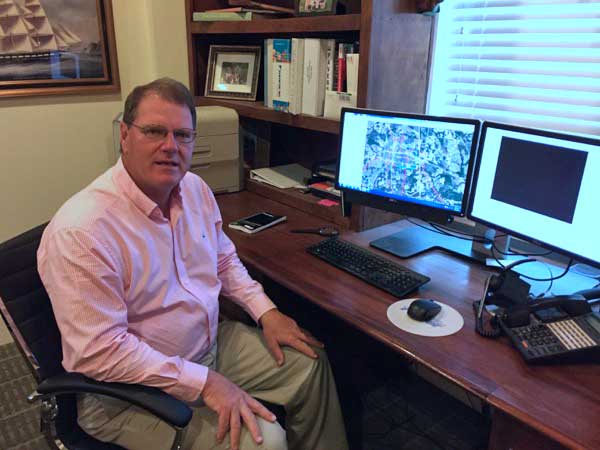
Meet
Greg Turton. Greg and his crew had a lot to learn and
accomplish before the project even started, as we
mentioned above. They also had to figure out how to
document the system as they designed and built it,
something they accomplished using Google Earth.
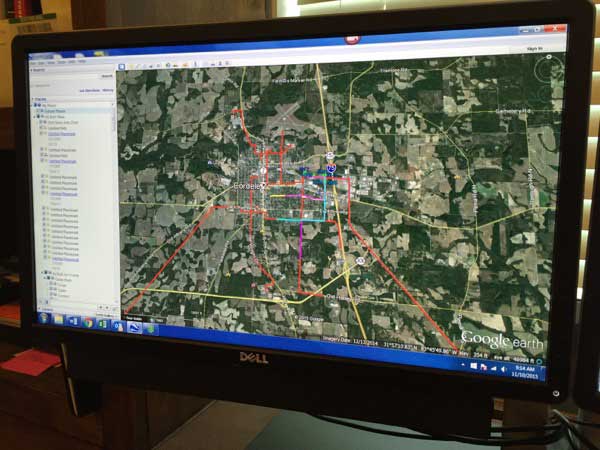
As
they started buying equipment for splicing and testing,
the needed a splice trailer. No problem, they built one.
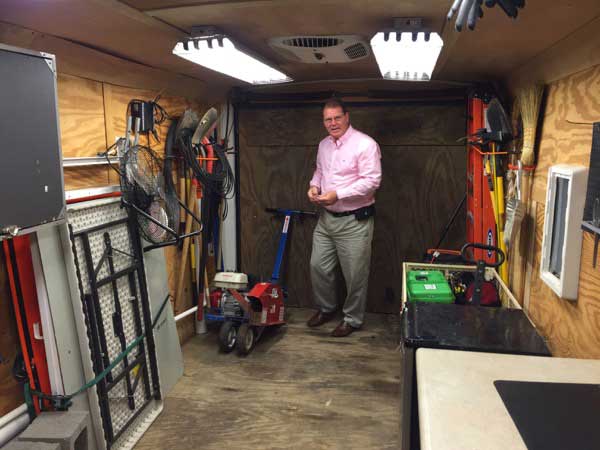
Based
on their training, they knew they needed a splicing
trailer for work in the chageable South Georgia weather. A
small converted travel trailer provided the base for their
splicing trailer and they furnished the inside with a work
counter and racks and cabinets for storage. Air
conditioning was furnished by a local company that wants a
fiber connection themselves. The white rectangle on the
right is the entry for the fiber optic cables being
spliced - a converted home doggy-door!
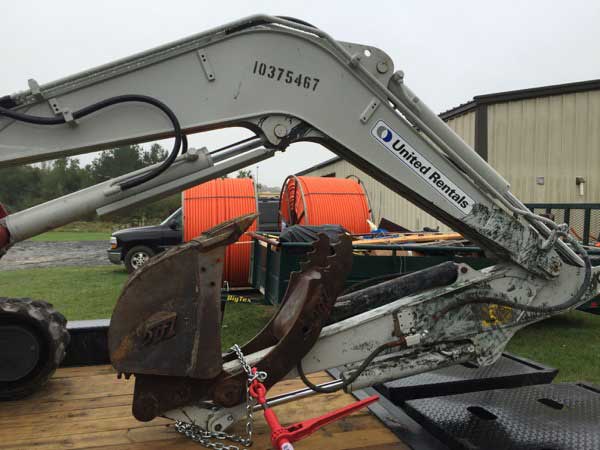
Rather
than investing in heavy equipment, they rent from local
companies. They converted a large utility trailer to carry
cables and conduit.
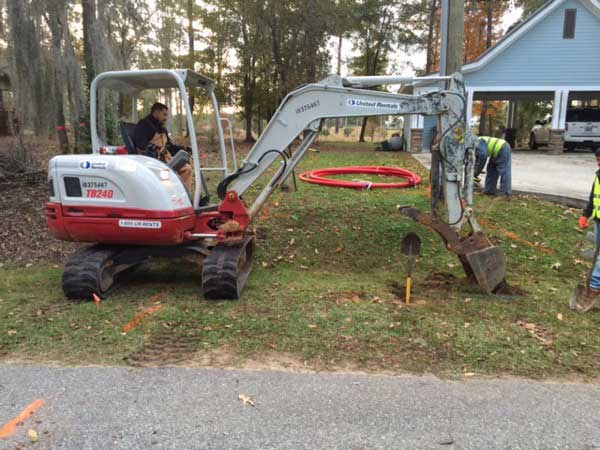
Most
cables were installed by trenching. In an area that has
lots of underground utilities, they had to be very
careful. They started by calling utilities before they
started and manually digging holes before using the
backhoe. Finding after a few near-misses that wasn't
sufficient, they bought a top quality underground locator
and learned how to use that to double-check before
digging.
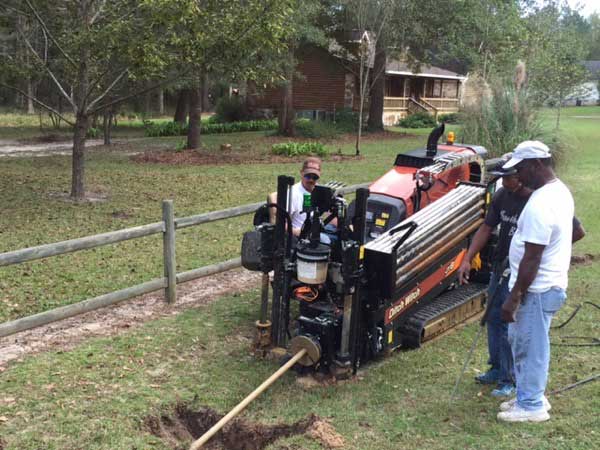
To
avoid digging up paved roads or driveways, they used
directional boring. It also worked well for several
bridges crossing small streams.
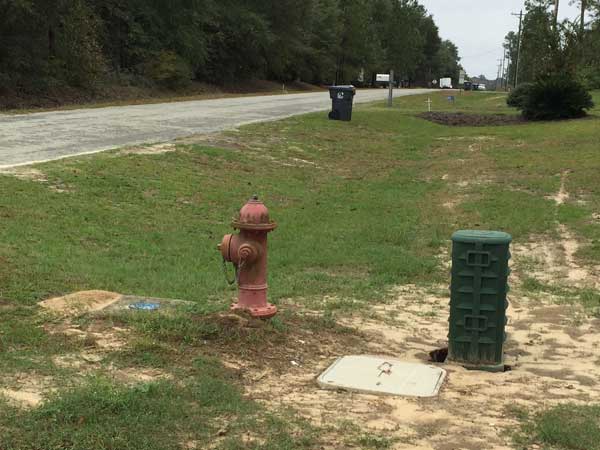
Splice
closures were put into hand holes or pedestals like
this one. The cable was laid along two lane roads
along with other utilities.
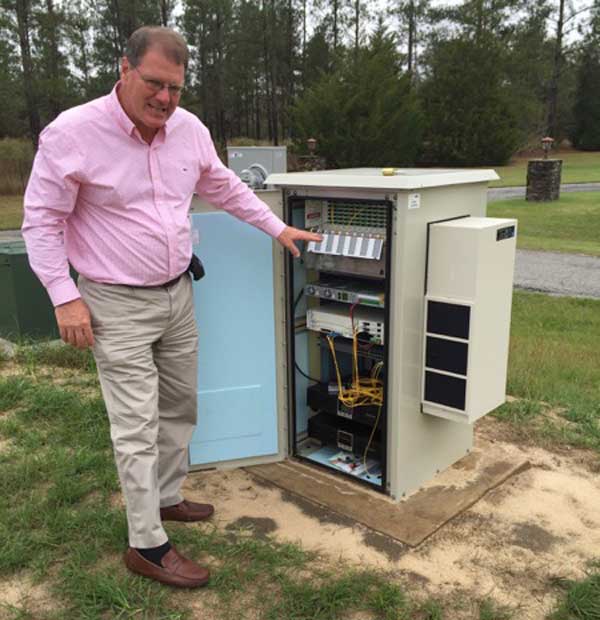
Here's
Greg with one of the equipment pedestals needed to get
connections into a remote area.
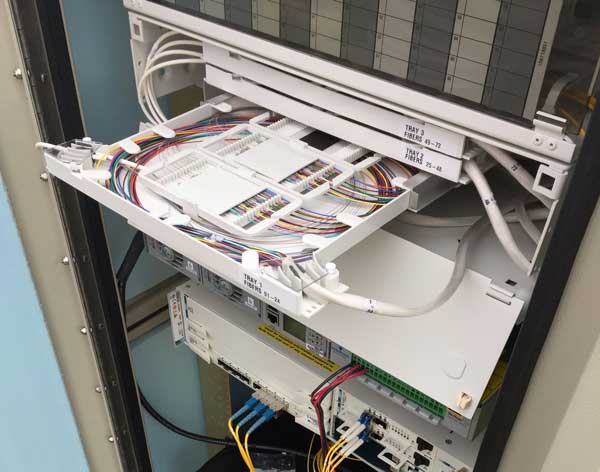
Neat
splice trays - they learned well from Eric Pearson's
training.
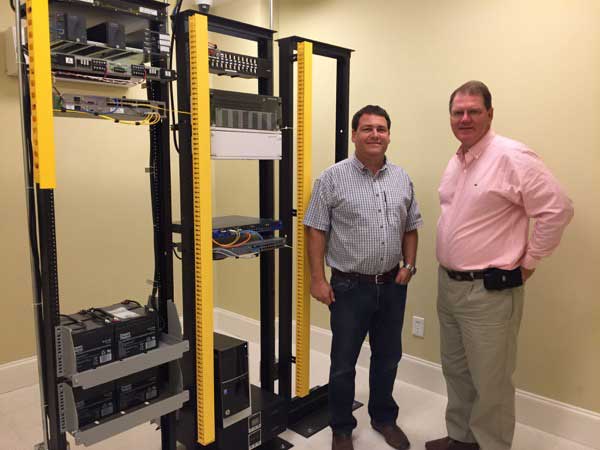
Here's
Greg and David Herlovich, his assistant, with the
equipment for their head end. They chose ADTRAN equipment
for their system because of their reputation, knowledge
and support, plus they are nearby in Huntsville, AL so
Greg can fly his plane over to visit the factory when
necessary.
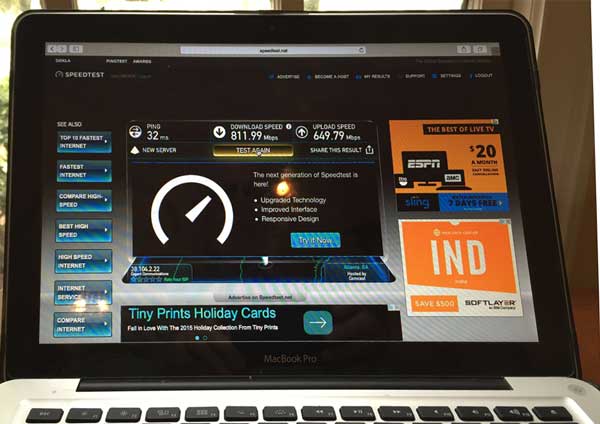
The
proof is in the performance, of course. This is a computer
at Greg's house connected to his network doing a
speedtest.

And
there you see the results of the speedtest on a "do it
yourself" gigabit FTTH network.
When
we visited Greg in November, 2015, Southern Fiberworx had
just started installation. They had already connected 30
homes and had over 100 scheduled for installation. His
original goal was to pass about 800 houses in his
development and sign up 30-40%. Southern
Fiberworx works like Google Fiber; get your
neighbors together and sign up and they build that
neighborhood next.
While we were in Cordele, we talked to some local
businesses and discovered that what Greg had been telling
us was true - the local enthusiasm for what he was doing
was amazing and people want to get connected ASAP. Because
Greg knows practically everybody in town and has talked to
many as he got permits and help building the system so
far, they know what he's doing and want him to expand
beyond his development to cover the entire town. As the
word spread, the county expressed similar interest in his
expanding the Southern Fiberworx footprint to cover the
county. Then the next county approached him with the same
idea.
While we were in Cordele, Greg asked us to visit his
bankers who wanted to know more about building a FTTH
network - you know, from the investment point of view. To
date, no kidding, Greg has funded Southern Fiberworx out
of his pocket! Yes, it does not cost that much to get
something like this started. But if he expands to the city
of Cordele and the two local counties, he may need to get
financial backers. We pointed out to the bankers that FTTH
provides high income with little overhead making good cash
flow. In addition, recently two CATV systems had been sold
for $5-6000 per subscriber - a whole lot more than it cost
to connect each of Southern Fiberworx subscribers on
gigabit FTTH. If that's not a good return on investment,
what is?
Southern Fiberworx is not the only independent FTTH
network FOA has been working with. We get calls often
asking how to get started and this is the best example we
have seen yet!
Connect
Anza
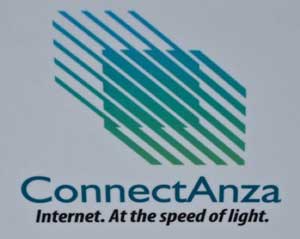
In
late 2014, Kevin Short, General Manager of the Anza
Electrical Cooperative called FOA to ask questions
about building a fiber optic network. FOA visited Kevin
and subsequently met with the Board of Directors of the
Coop to discuss ideas about building a fiber network over
their electrical network. Their electricity supplier was
pushing them to build fiber for grid management (Smart
Grid) and it seemed reasonable to assume that once the
backbone was built, expanding to provide Internet to their
customers was possible.
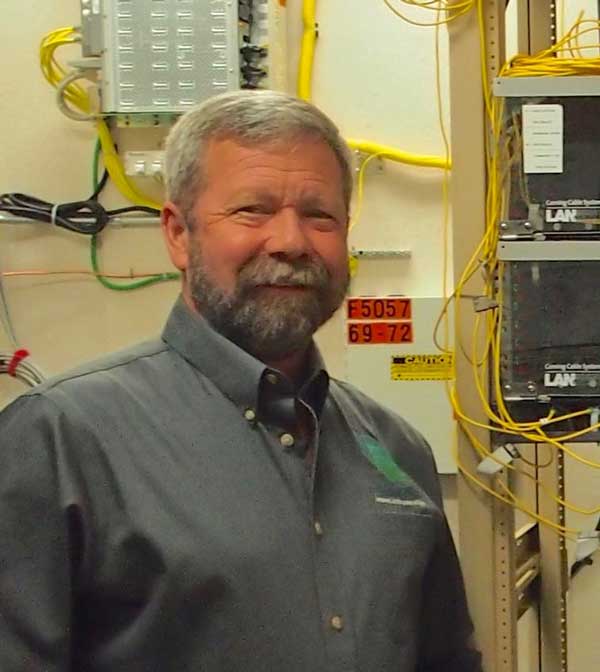
Kevin
Short, GM, Anza Electrical Cooperative
There was certainly a desire for better Internet because
they did not have any. It's easy to understand why. Anza
is really, really rural - located in the Southern
California high desert at the southern end of Mount San
Jacinto State Park.
Anza gets their electricity from an electric cooperative.
With the help of Franklin D. Roosevelt, who established
the Rural Electrification Administration in 1936, friends
and families banded together to create a new kind of
electric utility, where the voice of every person made a
difference. Electric cooperatives brought electric power
to the countryside when no one else would. Electric
cooperatives are owned by their members and focus on their
member needs and local priorities.
Anza Electric Cooperative, Inc. (AEC), energized in 1955,
is a member of Touchstone Energy® - the national brand of
electric cooperatives - providing power to the communities
of Anza, Garner Valley, Pinyon Pines and parts of Aguanga.
AEC provides power to 3900 homes, schools and businesses.
AEC's service area is nearly 700 square miles of high
desert with an elevation at roughly 4,000 feet where
winter weather can sometimes be a challenge. Anza is
located at an almost equal distance from Palm Desert,
Hemet and Temecula in Riverside County in Southern
California.
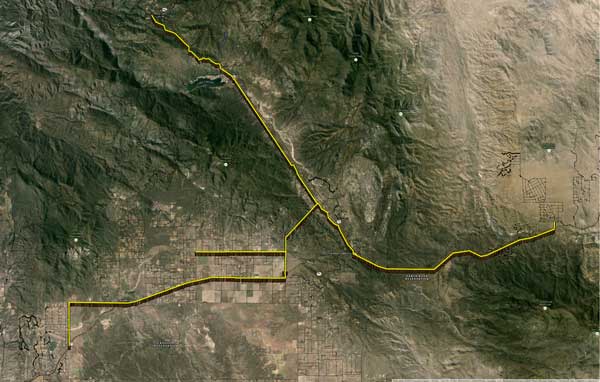
AEC's
fiber backbone run along their electrical lines.
While Anza is quite rural, it was only an hour's travel
from FOA HQ (then in Fallbrook, CA), so FOA President Jim
Hayes volunteered to do a series of half-day training
session for AEC personnel on fiber optics and installation
practices to familiarize them with what they would be
doing in the future to learn from the project so we could
share it with our readers.
AEC applied for and got a grant from the California Public
Utility Commission for $2.6 million, about $700 per
household, to help pay for the project. One thing is
important to understand about rural projects - they cost a
lot more than urban or suburban FTTH networks, and the
CPUC grant would cover only about half the total cost.
Since AEC is a coop, a bylaw change was voted on by Anza
Electric Cooperative members with an overwhelming 91.3% of
members approving the bylaw change to include fiber optic,
high speed internet service to our members along with our
traditional electric service.
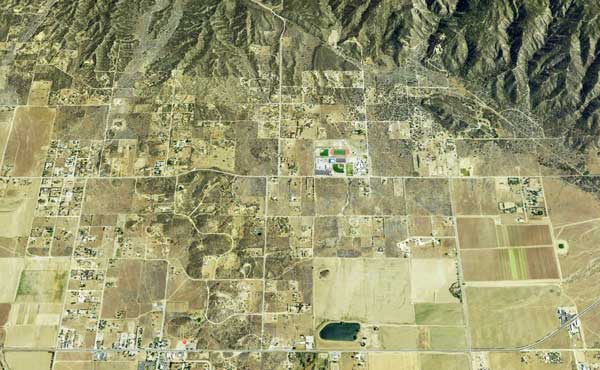
Anza
- mostly ranches and mountains
We
dubbed the AEC project "FTTR" for "fiber to the ranch"
because of the typical customers in the service area!
To
do the design of the network, AEC used a unique solution.
They enlisted Jeffery Willis, a local resident who was a
student at the University of Colorado, Boulder's
Interdisciplinary Telecommunications Program, to do the
design as expansion of a pre-existing Master's Capstone
project that AEC assisted him with. This was a
brilliant idea due the success of this college feasibility
study. Before getting started, Jeff performed a plethora
of research and development on all aspects of the design,
including a survey of design software which he shared with
FOA for our readers. FOA (JH) helped him with some fiber
issues but he had relatively little trouble doing a very
good design for the project. "
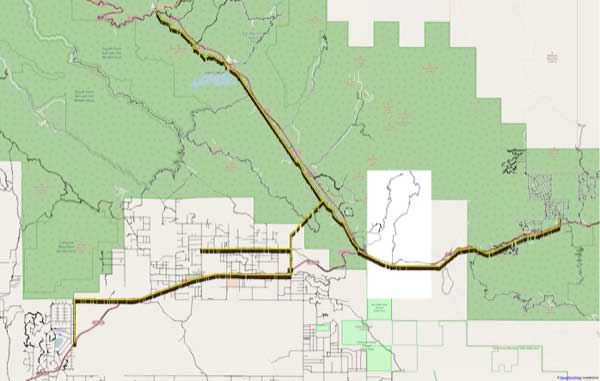
AEC's
fiber backbone plan
Much of the backbone ran along roads in the mountains that
connect the various population areas of the AEC service
area. Some areas had restrictions on where cables could be
run because the roads were designated "scenic routes."
One thing to consider in a project like this - you need
LOTS of cables! Anza had to store over a dozen spools of
cable - 20kft (about 4 miles or 6km) each, weighing
about 1600 pounds (726kg) each! Another thing they learned
was the length of the backbone was not the length of the
cable. They had to order 10-12% extra cable to accommodate
service loops, drops for splice closures, etc.
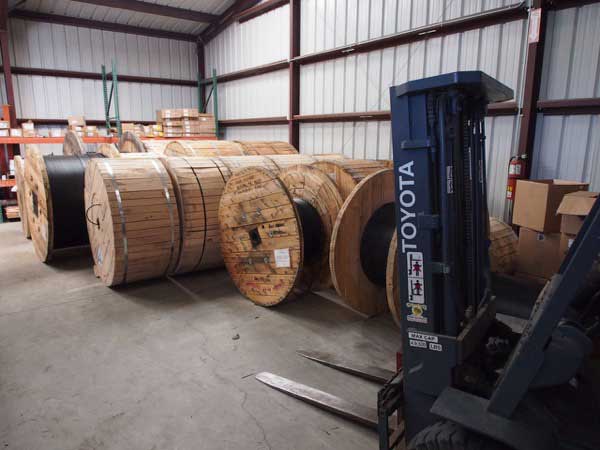
More
than 50 miles (80km) of cable stored in a AEC building.
They
also needed more equipment, including this bucket truck
purchased used, cleaned up and made into a rolling
advertisement for "Connect
Anza."
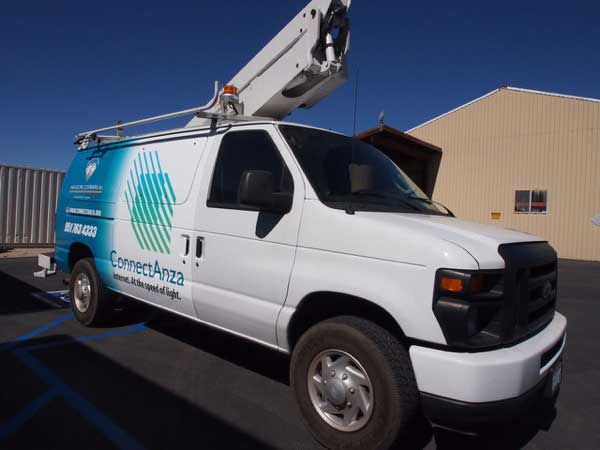
The
bucket truck advertises Connect
Anza.
Installation of the cable plant for ConnectAnza was
somewhat out of the ordinary. The area covered by the coop
included some areas without telephone service and poles
and/or messenger wires needed to be installed in many
areas. One section had to be bridged with wireless because
the rod was a "scenic highway" and poles and aerial cable
were not allowed!
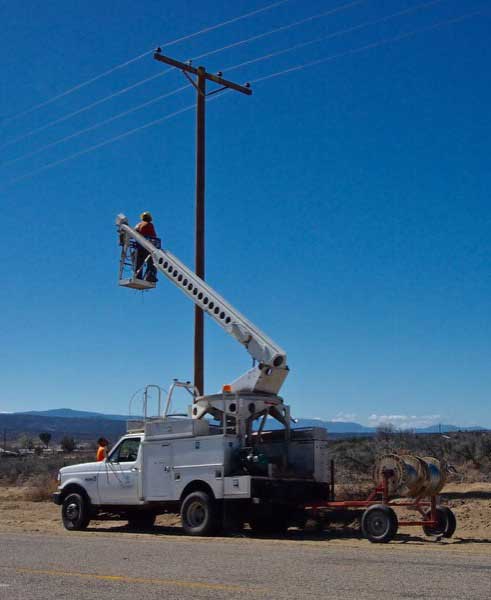
Installing messenger wires on the coops electrical poles.
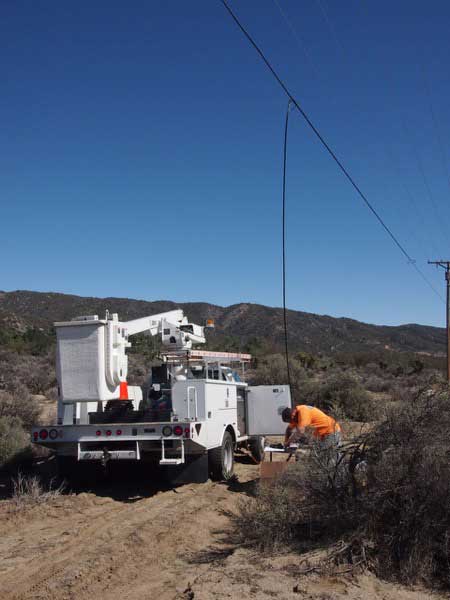
Splicing was done on the ground, often in the desert.
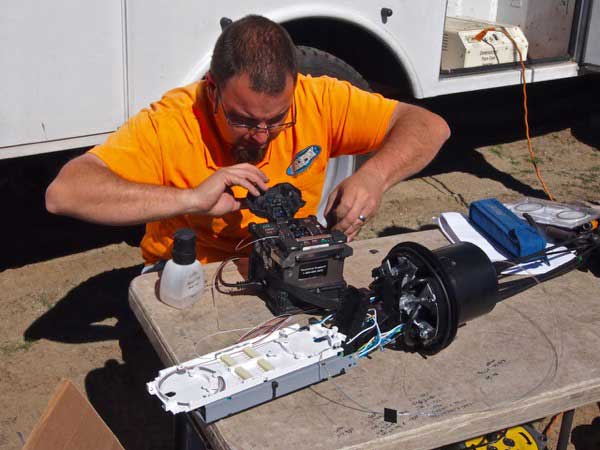
This
closure has provision for a PON splitter and several drop
cables.
The head end for ConnectAnza is installed at their main
office in the town of Anza. This rack includes the router
for their Internet service and the ADTRAN OLT equipment.
In the bottom of the rack is the backup batteries, an
important part of the equipment for an ISP.
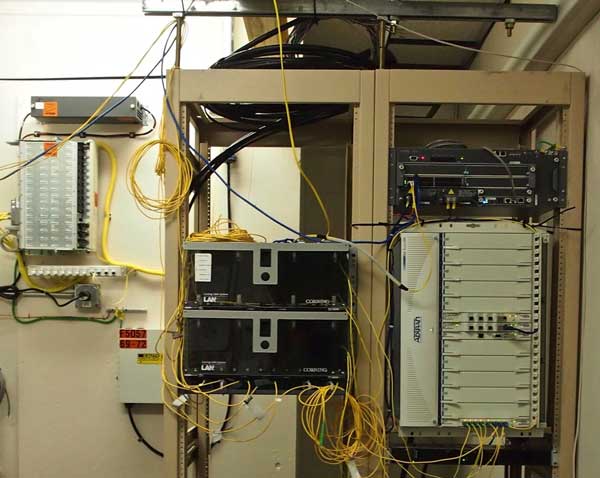
ConnectAnza
is now a fully functional ISP, one of the most rural
systems we know. They are proof that rural FTTH can be
built and it is certainly welcomed by their subscribers.
From no service, coop subscribers can get 100/100Mb/s
service for $49/month, 300/300 for $79/month. Low income
residents have a basic service of 20/20Mb/s for $20/month.
2021 Update
Since FOA began working with AEC in 2014, they have built out a large
part of the FTTH PON network, now connecting about 2,900 subscribers
including every business in their area. They also have gotten a RDOF
grant that will allow expansion of the network toward other small towns
nearby.
Besides the FTTH network, Anza has also made a significant commitment
to renewable energy, adding two solar farms of 3.5 megawatts and 1
megawatts. In additin, they have 2 megawatts of batteries online and 2.5
megawatts coming to allow providing 24/7 electricity from the solar
farms.
``
Satellite view of the 3.5 MW solar farm next to AEC offices under construction
AEC is a good example of how a small rural coop can successfully
provide state-of-the-art communications and power together in an area
that larger, for-profit companies would never consider possible.
LCS FiberCom
Three years ago, right after the beginning of the
pandemic lockdowns , FOA received an inquiry from Jamie Groskopf, asking
about getting a Do-It-Yourself (DIY) FTTH project started for a small town North of Houston, Texas.
After a half-dozen or so long and comprehensive emails, we heard no
more until December of 2022. I introduced him to Greg Turton of Southern
Fiberworx, one of the first to do a DIY FTTH project.
"I just wanted to reach out and give you a little update on the project I
started a couple years ago after reaching out to you for advice in the
Huntsville, Texas area north of Houston. We didn’t get construction
started until summer of 2021 and had 7 miles of cable to run to bring
fiber into the community. Inside the community we had another 78,000
feet of cable to install, mostly bored in and installed in conduit. We
have about 12,000 feet left to complete the main line installation past
every house and have made some progress in getting houses connected. We
just got our 100th subscriber connected and have another 200 signed up
and waiting in the community. "
"I took your advice and made friends with Grey Turton (Southern
FiberWorx) in Georgia. I made a couple trips out to spend time with him
and his team before making final decisions on which way to go."
Here's more about Jamie's project, LCS FiberCom, in his own words.
How did this project come about?
Waterwood is a large community in a rural area north of Houston, Texas.
The Property Owner’s Association approached several large providers to
build a modern alternative to the aging DSL system the local phone
company offers but the build costs didn’t meet their payback
requirements, even with incentives. There are over 28 miles of roads, a
golf course, and waterfront peninsulas with 2000 lots but only around
400 residences, which makes for a lot of additional build costs to cross
those undeveloped areas to reach the potential customers. The ground is
also particularly treacherous for this part of the state with very hard
sand/clay mixtures and random boulder sized rock formations. I proposed
a private project to build a modern fiber network that could remain
sustainable.
What background do you have?
I got my technical background started in the Air Force where I worked on
F-15 avionics systems. Later I got into security, automation, and
wireless systems as a hobby at first and then as a business. Fiber
optics intrigued me so I ordered a splicer and spent a lot of hours in
books and on YouTube learning what I could.
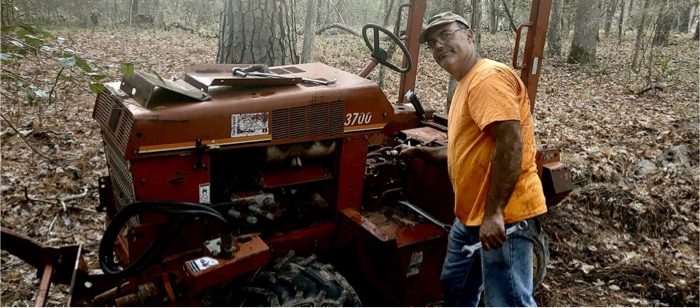
If you are building a DIY FTTH network, it helps to be a "Jack of
All Trades" because you may need to fix hydraulic hoses on your
equipment like Jamie can.
What type of system did you choose?
I looked at several topography methods and distribution systems. In the
end I chose the GPON system with a field split topography for price and
performance reasons. I looked at the 3 main GPON equipment providers but
when it was time to make the decision they all told me they could not
guarantee customer- end equipment (ONU/ONTs) and orders were as much as 6
months or more out with limits of 50 pieces. There were stories of
ISP’s not being able to add customers for lack of equipment. I wasn’t
sure if this was a legitimate shortage or a sales ploy to lock in early
orders but I couldn’t take that chance. I widened my search and finally
decided to contract manufacture my own GPON system from a large provider
overseas. I had to buy in bulk but they promised to have the entire
project worth of equipment manufactured and at my door in 30 days and
they came through as promised. I now have enough equipment to build
another community after this one as well as OLT spares. As an added
benefit this allowed me to tailor the specs to my needs and have the
items factory branded with LCS logos. I also offer VoIP telephone
services for those reluctant to abandon the telephone company and their
long-time home telephone numbers, which has been about 10% of our base
so far.
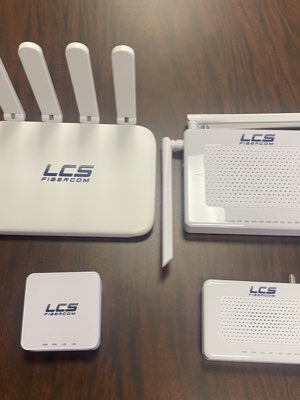 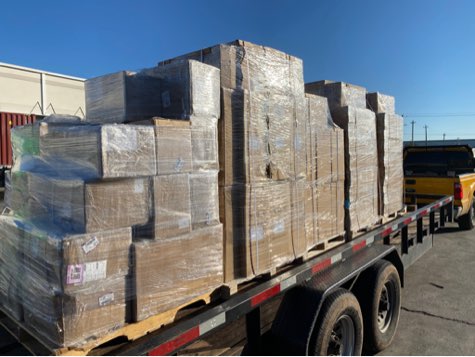
When suppliers couldn't provide products, LCS created their own.
Jamie had the electronics experience to do this but not every company
could. And it takes truckloads of equipment to build a FTTH network.
Have you been happy with the results?
I currently offer symmetrical 100Mbps and Gigabit plans. I’ve considered
offering a middle range plan as well as a 2-gig download option in
select areas but haven’t decided if I want to deal with the headache of
upgrading customers to multi-gig networking hardware yet. The network
handled the additional test demand well. We are too far out to have
redundant fiber ring options so we connect to our data center on a
single transport path. We had an outage on that path in May when the
main cable was severed in an adjacent city that took the provider half
the day to repair. Our local system has been working at a 100% rate.
What are your favorite and least favorite parts of construction?
I enjoy most of the construction. I have become quite a good horizontal
drill rig operator but I’m going to say using the large quad plow to
muscle in conduit at 4 feet deep several thousand feet per day is always
fun. My least favorite is probably just the Groundhog Day feeling of
chipping away at such a large amount of work day after day. I’ve worked 7
days a week for 18 months, averaging about one day away per month. At
some point I will be able to reduce my workload to something healthier
and more sustainable. It’s funny though, the few days I have taken off I
almost feel guilty about, thinking “I could have reached that goal
point today”. This type project definitely becomes all-consuming, at
least for me it has.
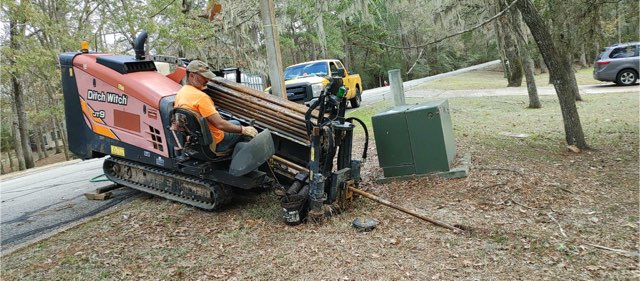
Jamie, like his mentor Greg Turton, likes to do construction work himself.
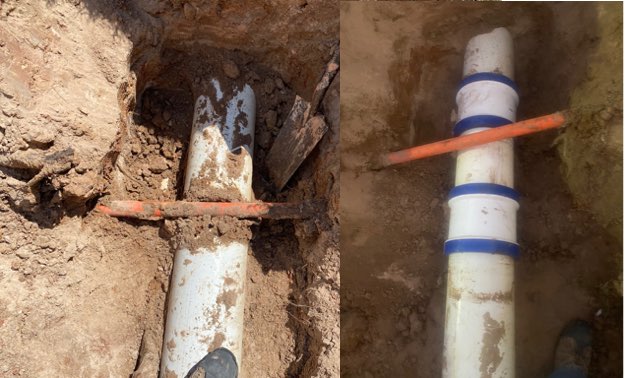
Not everything goes right - a water main for a golf course was damaged while directional boring and repaired.
What skills do you rely on most for this project?
All of them! When you take on a project like this you become engineer,
technician, politician, foreman, import specialist, customer relations,
field mechanic, salesman, contract negotiator, legal expert, government
liaison, plumber, electrician and more. You have to plan for some steep
learning curves because most people may have two or three of those
skills honed well, but you need all of them and more to keep moving
forward and give you a chance at success. I am very thankful for the few
people who have stepped in to help me where they can.
What would you do differently in hindsight?
Tough question, I don’t like to second guess past decisions. Looking
back there are some minor things that could have been improved but
overall, I was extremely fortunate that the decisions I made worked out
so well. It could have easily gone south if some of the non-traditional
choices didn’t work out well. Lots of research and asking questions
helped. My fiber management skills have improved a lot with practice so
at some point I will probably go back into the early splice points and
pedestals to organize them better but they are all working fine as is so
that is low on my to-do list.
Are your customers satisfied?
That is my main focus and I think I’ve done pretty well with that. I
personally meet with each customer at installation time and try to
follow up shortly after installation. The biggest issue I’ve had is the
same across the entire industry, customer’s WiFi expectations. I try to
assess each customer’s needs for WiFi at their home and educate them on
how to meet their expectations on their budget. I provide a wifi router
with the service but some customers with larger homes expect a one-size
fits all solution that just isn’t realistic. I make it a point to
explain the differences between extenders and mesh systems and why
getting their full gigabit to a single device over wifi is a tall order
even with their large 8 channel 5400 Mbps WiFi-6 gaming routers. It
amazes me that larger providers do all this work to bring service into a
customer’s home and then let their reputations suffer because the
customers experience poor service with the last 50 feet of connection
over underperforming wifi.
Did the pandemic cause problems?
Of course! I could write an entire article on those issues. It caused
delays for parts to repair equipment, labor shortages, cost increases,
and electronics equipment availability concerns. Our upstream provider
delayed our primary connection for several months as their crews were
constantly in some form of isolation or emergency coverage for most of
2021
How much has it cost, are you turning a profit yet?
A lot. I started doing initial budgeting and set my numbers in late 2019
which were used when the project started. The pandemic followed by the
government throwing billions of dollars to large providers to upgrade
their networks caused prices to increase substantially, as much as
triple on some items, and sub-contractors to be in short supply with
their prices increasing by 50-100%, and more recently the Fed’s interest
rate hikes have made profitability that much harder to reach.
I initially decided to keep total costs manageable by doing the bulk of
construction in-house so fortunately there was a degree of insulation
from the chaos going on in the fiber world but all the major materials
needed for construction have increased substantially since my initial
budgeting. Despite those issues and Waterwood having low home density
with so many miles of undeveloped lots to pass and 6 miles to bring
initial service into the community, I managed to keep the total cost per
passing at manageable levels by doing the bulk of the work with only
myself and one or two guys.
Recently I have been able to bring on an operator for the boring rig
with one or two of his guys because his machine is out for major
repairs. This has allowed me to catch up with splicing and getting
customers connected. To date we have 102 customers connected after
installing 70,000 feet of conduit and 170,000 feet of fiber-optic
cabling. We have 15,000 feet of conduit and 30,000 feet of cable left to
install with 200 more customers waiting for service. I expect to have
most connected by summer.
What is next for LCS Fibercom?
I’m looking for other areas to expand into and potential municipal or
utility partners to work with in the future. I laid the groundwork for
the network to expand into non-contiguous areas so I’d like to find
another community that wants improved services and keep growing.
More about LCS FiberCom
Additional
Reading on Rural FTTH
The
August
2021 issue of the FOA Newsletter compares rural
broadband today with rural electrification almost a
century ago. The situations are quite similar and the
solutions, including assisting rural electrical or telco
coops, are quite the same.
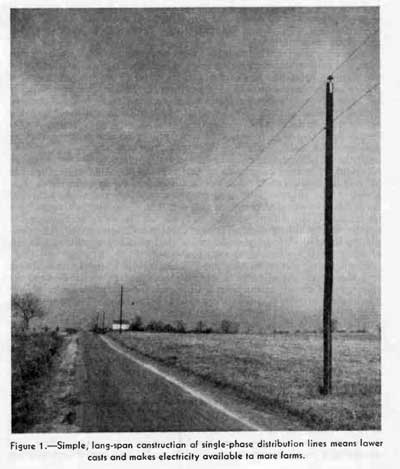
From the 1940 USDA yearbook article on rural
electrification.
If You Are
Considering DIY FTTH, Here Are Things To Remember
Legality: If
you are in one of 18 US States, your state legislators
have passed laws written by lobbyists for incumbent
service providers that prevent municipalities, other
governments or coops from becoming ISPs. Check the map
here. See
the map here. By the time you read this, all
this may have been negated by local or Federal laws.
Uniqueness: Like most fiber optic networks,
every FTTH installation is unique. It must be designed for
the location it is to serve and choices on components and
installation methods should be optimized for the system.
Construction and installation methods may include every
type of OSP installation. Suppliers familiar with FTTx can
advise customers on what others have done to make
installations simpler, easier and less expensive. Most
systems prefer to use as many factory-made components as
possible as they are generally less expensive than doing
the same work in the field. New installation methods
should be considered as well to reduce costs.
Consultants:
Be wary of consultants. Consultants can be
extremely valuable in designing a FTTH system, as long as
they have relevant experience, are up to date on new
components and techniques and are highly recommended by
previous clients. Unfortunately we have seen problems with
consultants, including over-designed networks with costs
much higher than necessary, installation practices
recommended that were unnecessary or ignore newer
technology, systems designed around components that were
higher performance (and price) than necessary, and in one
case a consultant took the clients payment, went away for
a year and came back with an admission that they could not
design the network (but they kept the consulting fees.)
Contractors: As with any fiber optic project, the
quality of the installation depends on the quality of the
installer. Look for contractors with knowledge, experience
and references. And preferably relevant certifications
like the FOA CFOT. Be especially wary of subcontractors.
Any subcontractors should have equal qualifications and be
approved by the network owner. We have seen landscape
contractors with no fiber training used as subcontractors
for cable plant installation - one cut several cables to
buildings that had been installed by a member of the FOA
advisory board!
Call Before You Dig! Every day some major fiber
optic cable is cut by a contractor.
The jurisdiction issuing permits should help you with
locating other buried utilities. There is
a service that helps you locate underground utilities that
may be in your construction path. See the FOA web page on
Digging
Safely.
What Fiber Do
You Already Have? Before you
design or install a new fiber optic cable plant, inventory
the fiber you have already and/or negotiate to lease fiber
where others have cables with dark (unused) fibers. Also
talk to other organizations who may need communications to
see if they want to share costs or lease dark fibers or
communications links from you. Cities, counties and states
need fiber. Utilities need fiber. Fire and life safety
organizations need fiber. Traffic departments need fiber.
Cellular companies really need a lot of fiber.
What Other
Services Can Share The Fiber? Consider what
other services than FTTH you can carry on your fiber optic
cable plant - cellular backhaul, traffic systems,
security/surveillance systems, leased fiber, etc. to
generate additional revenue. A few years ago a large
American city sent out a RFP (request for proposal) for an
urban FTTH network. The document dealt strictly with FTTH
to connect the city's citizens with fiber and ignored all
the other services the city had that already used or
needed fiber - city communications, security/video
surveillance, intelligent traffic management, public
transportation communications, wireless networks(small
cells and 5G), utility communications, etc., etc., etc.
Dig Smart -Dig
Once: This same document also covered
the difficulty of urban installation - digging up streets
already filled with underground utilities, limited space
for pedestals, few options for aerial cable and
other issues that are typical problems for urban fiber
installation. No mention of "Dig Once" to make future
installations easier. Share fibers. Use spare fibers. Use
additional wavelengths in current fiber. Consider all the
alternatives. Plan ahead - future proof is a myth, but one
can make certain decisions that will make the future
easier. If you are considering using
FTTH design software, ask to talk to customers who have
used it. Determine what you need to know first in order to
use it, e.g. GIS data on every utility pole, manhole or
handhole, subscriber location, etc. and how much training
it takes to become proficient. Will you use your personnel
or hire outsiders, and how do you evaluate them.
Cost Savings:
Fiber optic cable and components are not
expensive, but labor is. Saving money on components may
look good in first analysis, but more savings will come
from optimized designs and efficient installation
practices. More experienced contractors are more efficient
and may save costs by their speed and efficiency.
And design for the future - if you dig a trench for
anything, not just fiber but any underground utility, bury
a number of fiber ducts for future use, install cables
with more fibers than you need - lots more - fiber is
cheap, installation is expensive. The program is called
"Dig Once."
Take Rates Are
Important: "Take rates" for new FTTH networks
vary from low to high, depending on the satisfaction with
the current ISP (Internet service provider.) When Google
Fiber started in Kansas City, the take rate was high
because the current service was bad, but in later cities
when the local ISPs knew they were coming and improved
their service and/or lowered their prices, the take rate
was lower. Competition tends to drive take rates and take
rates determine the economics of the system, Know your
competition. Offering gigabit services are often the top
selling point of FTTH. Every GPON network is a gigabit
network, but subscribers can opt for slower speeds at
lower costs.
What Makes
A Successful Fiber Optic Project?
People call FOA for advice all the time. Most of the calls
deal with technical questions about products, installation
and testing. But in one call; a manager who was starting
to plan a fiber optic project wanted advice on how to
proceed. It was a long call! His basic question was “What
does it take to have a successful fiber optic project?” We
responded with 4 words: financing, commitment, expertise
and patience. (This section is repeated from the
introductory section on FTTH because it's important for
the designer and managers of a FTTH project.)
Financing: The story goes that
someone asked Neil Armstrong what he was thinking about
while sitting on top of the rocket ready to launch Apollo
11 to the moon. “Every part was made by the lowest
bidder,” was supposedly his reply. (The same quote has
been attributed to most early astronauts!)
Fiber optics are not necessarily
expensive; in fact, fiber has been used so widely because
it is the least expensive communications medium in
virtually all projects. But fiber optic projects may
require a lot of construction which makes the project
expensive. Like all other projects, it never pays to cut
corners. Planning and running the project properly is what
saves money, trying to cheapen the project. Not all jobs
should go to the lowest bidder, unless they meet all the
criteria for a qualified bidder. Likewise, one needs to
ensure that when a project starts, there are funds
available to complete the job properly, including some
extra for unplanned changes or modifications.
Commitment: Just like having
sufficient finances to compete the project, one needs a
commitment to finish the job once it is started. Changes
of management or changes in governments often lead to
confusion or even modifying a project in midstream. There
is nothing wrong with making changes based on what learns
as the project progresses; it may even involve greater
efficiency or cost savings, but arbitrary changes may
jeopardize the project's timetable, completion or even its
usefulness.
If the project is under the auspices of
a government entity, changes in administration or
management that causes changes in a project will
invariably make it more expensive and may jeopardize the
success of the entire project. Ideally, the personnel who
propose, design and plan the network should see it to
completion.
Expertise: Fiber requires
expertise and experience. It's obvious the installers need
to know what they are doing, but in reality, so must the
managers who work for the organization that is contracting
for the work. There are many instances of projects where
the managers signed off on the project when it was
incomplete or improperly installed. The only way to
properly manage a project is to understand every aspect of
it well enough to know if it is being done properly and
when it is actually complete.
Planners, designers, contractors and
installers should all be trained and certified
as well as being experienced with good references. That
holds doubly so for consultants. In many places, to be a
consultant or cabling contractor means little other than
registering as a business and advertising your services.
Some of the problems we've seen with outside services,
include consultants who took contracts, spent time on a
project, then told the customer they could not help them
with the project, but kept the money.
We have seen contractors doing shoddy
installations, ruining expensive fiber optic cable during
pulling and leaving jobs half done but getting paid
because the customer knew no better. One of the biggest
problems is subcontractors. A contractor with good
credentials gets the job but subcontracts some of the work
to a contractor who will do the work at a lower price, but
does not have the training or experience (or motivation)
to do it right. In your contract with an installer, we
recommend a clause giving the project manager
responsibility for evaluating and approving all
subcontractors.
The manager must know better to prevent
problems. FOA also has pages on what
the manager needs to know.
Patience: From concept to
acceptance, a typical OSP fiber project can take 2-5 years
and a premises project 1-2 years. It depends on the size
of the project, the time to properly design it, create
project paperwork, get permits, buy components, hire
contractors and properly install it. Proper
workmanship takes time and is not easily rushed. Saving
time generally means cutting corners and that is often the
cause of the problems encountered. Take your time, plan,
design, select, install, test and document your network
properly.
And by the way, "future proofing" is a
myth! Who would have known in 1990 how ubiquitous the
Internet would be today? How reliant we could be on
smartphones other mobile devices? How many workers would
be working remotely or using videoconferencing for
meetings? Technology moves too fast and is too disruptive
for anyone to make reliable predictions. The IBMer who
developed MRP - the original company organizational
software - used to tell everyone, "A forecast is wrong
from the moment it is made." Plan for the future, but
assume you will upgrade, change directions, etc. driven by
new tech and changes in the world around us.
- Technical
Information on FTTX From The FOA
Online Guide:
- FTTH
Introduction
- FTTH
Architectures,
- FTTH
in MDUs (Multiple Dwelling Units)
- FTTH
PON Standards, Specifications and Protocols
- FTTH
Design
- FTTH
Installation
- FTTH
Customer Premises Installation
FTTH
Network Testing
FTTH
Case Studies: Do-It-Yourself FTTH
FTTH
Project Management
Migration from GPON to 10GPON
- The
Fiber Optic Association Fiber To The Home Handbook:
For Planners, Managers, Designers, Installers And
Operators Of FTTH - Fiber To The Home - Networks
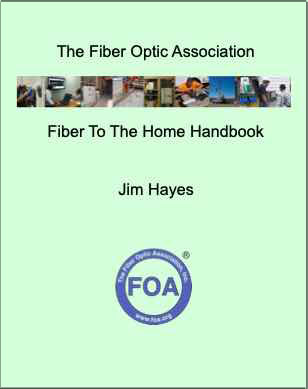
The
Fiber Optic Association Fiber To The Home
Handbook Available
in paperback or as an eBook on the Amazon
Kindle Available
direct from Amazon.com,
local booksellers and other distributors.
- Training
& Certification
Fiber
U Online FTTx Self Study Program (free)
- FOA
Certification Overview
FOA
FTTx Certification Requirements
FOA-Approved
Training Programs
Table of Contents: The
FOA Reference Guide To Fiber Optics
|
